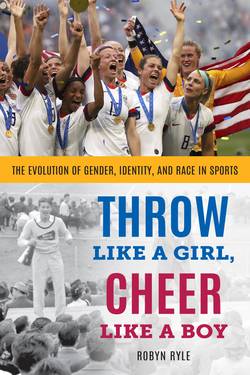Читать книгу Throw Like a Girl, Cheer Like a Boy - Robyn Ryle - Страница 23
На сайте Литреса книга снята с продажи.
Looking Like the “Right” Kind of Woman:
Gender Testing, Race, and Geography
ОглавлениеThat it might be impossible to use any biological criteria to determine gender didn’t stop the IAAF and the IOC from trying, however. In a story similar to that of Caster Semenya, Dutee Chand, one of India’s fastest runners, was preparing for her first international adult track event when she got a call from the director of the Athletics Federation of India. The director was calling to ask Chand to undergo a series of medical tests to prove her gender. These tests forced Chand to demonstrate that she really was a woman rather than a man trying to gain a competitive advantage by competing as a woman. Chand had grown up never considering she was anything but female, so these demands that she prove her gender came as a complete surprise. By 2014, when Chand was informed she wouldn’t be able to compete, both the IAAF and the IOC had abandoned comprehensive gender testing. But the two organizations still retained the right to test “suspicious” individuals, despite widespread protests. In practice, this policy often meant targeting female athletes who didn’t fit notions of what a feminine body should look like or who were particularly successful in their sport.
These policies raise questions about exactly what a “feminine” body looks like, and how that might intersect with notions of race. Many critics have pointed out the fact that the women who have been recently targeted for gender testing tend to be women of color from the global South. Supporters of both Semenya and Chand argue that their geography and race may be the real reason for being targeted by the IAAF. Katrina Karkazis is a Stanford University bioethicist and expert on intersex issues who has pointed to the role of race in these two cases. “All of these [efforts] seem to coincide with the recent dominance by women from Sub-Saharan Africa in certain track and field events, and that wasn’t the case before,” Karkazis said. “That is one way this is racialized. Who is winning those events? Who has won historically?”[18] Supporters like Karkazis wonder if the IAAF would have pursued Semenya for nearly a decade if she were a white runner from the global North. These critics note that officials haven’t targeted any female athletes as “suspicious” in events with a demonstrated correlation between testosterone and performance (like the pole vault and the hammer throw). That’s because white women dominate in those sports, rather than women like Semenya or Chand.
Semenya’s case also demonstrates the ways in which our ideas about femininity are racial and cultural. Bruce Kidd, a University of Toronto professor and longtime member of the Olympic movement, points out the way differences in men’s sports are celebrated. “We encourage nations to send athletes regardless of how they look, their size and shape, and we celebrate those athletes who are at the extreme, the outliers,” he said of men’s sports. “In women’s sport, the dominant discourse is that woman should look like the European, North American, Caucasian expectation of femininity and that they should conform to a hormonal requirement that belies the science and is not expected of the men.”[19] In other words, Semenya and Chand weren’t targeted because they don’t look feminine, but because they don’t look like a very specific version of femininity.
